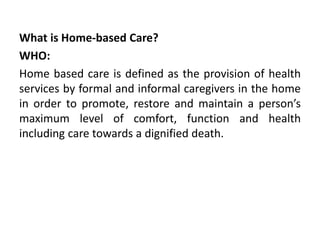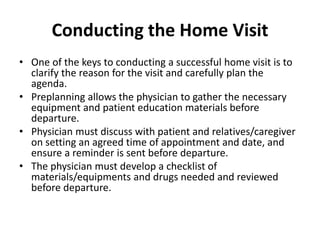Home-based Care (HC) is defined as the provision of health services directly in the home to promote health and comfort. It aims to shift care from hospitals to the community. HC targets those who need assistance to live at home, including the healthy, at-risk, disabled, recovering, and terminally ill. Stakeholders include healthcare professionals, NGOs, community members, and clients. HC has advantages like reduced costs, empowerment, and person-centered care but challenges include stress on caregivers and resource constraints. Home visits are a key part of HC and include illness, end-of-life, assessment, and post-hospitalization follow-up visits.






























![Bibliography
• Amoran OE, Ogunsola EO, Salako AO, Alausa OO. HIV/aids related home based care
pratices among primary health care workers in ogun state, Nigera. BMC Health
Services Research 12, 112 (2012). https://doi.org/10.1186/1472-6963-12-112
• Chizoba AF, Chineke HN, Adogu POU. Roles ofo traditional birth attendatns in
prevention of mother to child transmission of HIV in nigeria: a brief review. Journal
Advances in Medicine and Medical Research. 2020; Vol 32 [issue 20], 58-67.
https://doi.org/10.9734/jammr/2020/v32i2030685
• Alawole GO, David AA. Assessment of the design and implementation challenges
of the national health insurance scheme in Nigeria:a qualitative study among
subnational level actors, healthcare and insurance providers. BMC Public Health
21, 124 (2021).
• Egwim JI. NPMCN Update course: Home-based care. 2017
• Unwin BK, Jerant AF. The home visit. American family physician. 1999
Oct;60(5):1481-8.
• South African Republic. National Guideline on home-base care/community-based
care.
• World Health Organisation. Community Home-Based Care Training. (Cited 2016,
Jan 12). Available from:
http://www.searo.who.int/myanmar/areas/hivaidschbctraining/en/.](https://image.slidesharecdn.com/home-basedcare-teamd-210530205921/85/Home-based-care-31-320.jpg)
